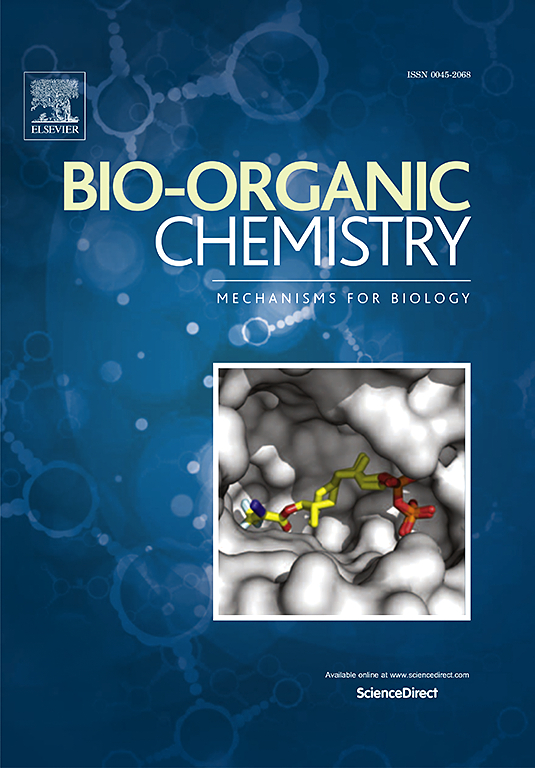Synthesis and exploration of anticancer potential of spirocyclic 1,2,3-triazoline and aziridine derivatives of natural eudesmanolide isoalantolactone
IF 4.5
2区 医学
Q1 BIOCHEMISTRY & MOLECULAR BIOLOGY
引用次数: 0
Abstract
Eudesmane-type sesquiterpene lactone isoalantolactone 1 is of great interest due to its availability, biological activity and synthetic application. Respective series of original spirocyclic (11S,5ʹ) (1,2,3-triazoline-eudesma-4,15-enolides) and (11S)-aziridine-eudesma-4,15-enolides were efficiently synthesized via a chemoselective 1,3-dipolar cycloaddition reaction of organic azides to the exocyclic double bond of the lactone ring of isoalantolactone or 13E-(aryl)isoalantolactones by heating in DMF or toluene. The thermal reactions of isoalantolactone with benzyl azide, 2-azidoethanol, or n-butyl azide in 2-methoxyethanol afforded 13-(alkyamino)isoalantolactones formed as a mixture of (Z) and (E)-isomers. The results of in vitro biological assays showed that novel spirocyclic isoalantolactone derivatives exhibited cytotoxicity against human breast cancer and glioblastoma cells at low micromolar concentrations. The most cytotoxic and selective (11S,5ʹ)-spiro-1,2,3-triazoline from 13E-(fluorophenyl)isoalantolactone 20 (IC50(MCF-7) = 8 ± 0.1 µM, SI(MCF-7) > 12.5) was found to induce ROS-dependent death of MCF-7 human breast cancer cells via mitochondrial apoptosis. The corresponding (11S)-spiroaziridine derivatives 21 at non-toxic concentrations (10 and 20 µM) effectively suppressed motility, clonogenicity and adhesion of glioblastoma cells and exhibited synergistic cytotoxicity in combination with temozolomide. In silico analysis revealed the potential ability of the 13-aryl (11S)-spiroaziridine derivative 21 to bypass the blood–brain barrier and exhibit anti-glioblastoma activity probably based on the direct interaction with Hsp90α.

天然桉叶内酯异金刚烷内酯的螺环 1,2,3 三唑啉和氮丙啶衍生物的合成及其抗癌潜力的探索。
尤德斯曼型倍半萜内酯异丙酸内酯1因其可得性、生物活性和合成应用而受到广泛关注。在DMF或甲苯中加热,有机叠氮化物与异丙酸内酯或13E-(芳基)异丙酸内酯外环双键发生化学选择性1,3-偶极环加成反应,分别合成了原螺环(11S,5′)(1,2,3-三唑啉-eudesma-4,15-烯内酯)和(11S)-叠氮啶-eudesma-4,15-烯内酯。异丙酸内酯在2-甲氧基乙醇中与叠氮化苄、2-叠氮乙醇或叠氮化正丁酯发生热反应,生成13-(烷基氨基)异丙酸内酯,形成(Z)和(E)异构体的混合物。体外生物实验结果表明,新型螺环异丙酸内酯衍生物在低微摩尔浓度下对人乳腺癌和胶质母细胞瘤细胞具有细胞毒性。13E-(氟苯基)异丙酸内酯20 (IC50(MCF-7) = 8±0.1µM, SI(MCF-7) > 12.5)中最具细胞毒性和选择性的(11S,5′)-螺-1,2,3-三唑啉通过线粒体凋亡诱导MCF-7人乳腺癌细胞ros依赖性死亡。相应的(11S)-螺氮吡啶衍生物21在无毒浓度(10和20µM)下可有效抑制胶质母细胞瘤细胞的运动性、克隆性和粘附性,并与替莫唑胺联用时表现出协同细胞毒性。硅分析显示,13-芳基(11S)-螺氮吡啶衍生物21可能具有绕过血脑屏障并表现出抗胶质母细胞瘤活性的潜在能力,这可能是基于与Hsp90α的直接相互作用。
本文章由计算机程序翻译,如有差异,请以英文原文为准。
求助全文
约1分钟内获得全文
求助全文
来源期刊

Bioorganic Chemistry
生物-生化与分子生物学
CiteScore
9.70
自引率
3.90%
发文量
679
审稿时长
31 days
期刊介绍:
Bioorganic Chemistry publishes research that addresses biological questions at the molecular level, using organic chemistry and principles of physical organic chemistry. The scope of the journal covers a range of topics at the organic chemistry-biology interface, including: enzyme catalysis, biotransformation and enzyme inhibition; nucleic acids chemistry; medicinal chemistry; natural product chemistry, natural product synthesis and natural product biosynthesis; antimicrobial agents; lipid and peptide chemistry; biophysical chemistry; biological probes; bio-orthogonal chemistry and biomimetic chemistry.
For manuscripts dealing with synthetic bioactive compounds, the Journal requires that the molecular target of the compounds described must be known, and must be demonstrated experimentally in the manuscript. For studies involving natural products, if the molecular target is unknown, some data beyond simple cell-based toxicity studies to provide insight into the mechanism of action is required. Studies supported by molecular docking are welcome, but must be supported by experimental data. The Journal does not consider manuscripts that are purely theoretical or computational in nature.
The Journal publishes regular articles, short communications and reviews. Reviews are normally invited by Editors or Editorial Board members. Authors of unsolicited reviews should first contact an Editor or Editorial Board member to determine whether the proposed article is within the scope of the Journal.
 求助内容:
求助内容: 应助结果提醒方式:
应助结果提醒方式:


